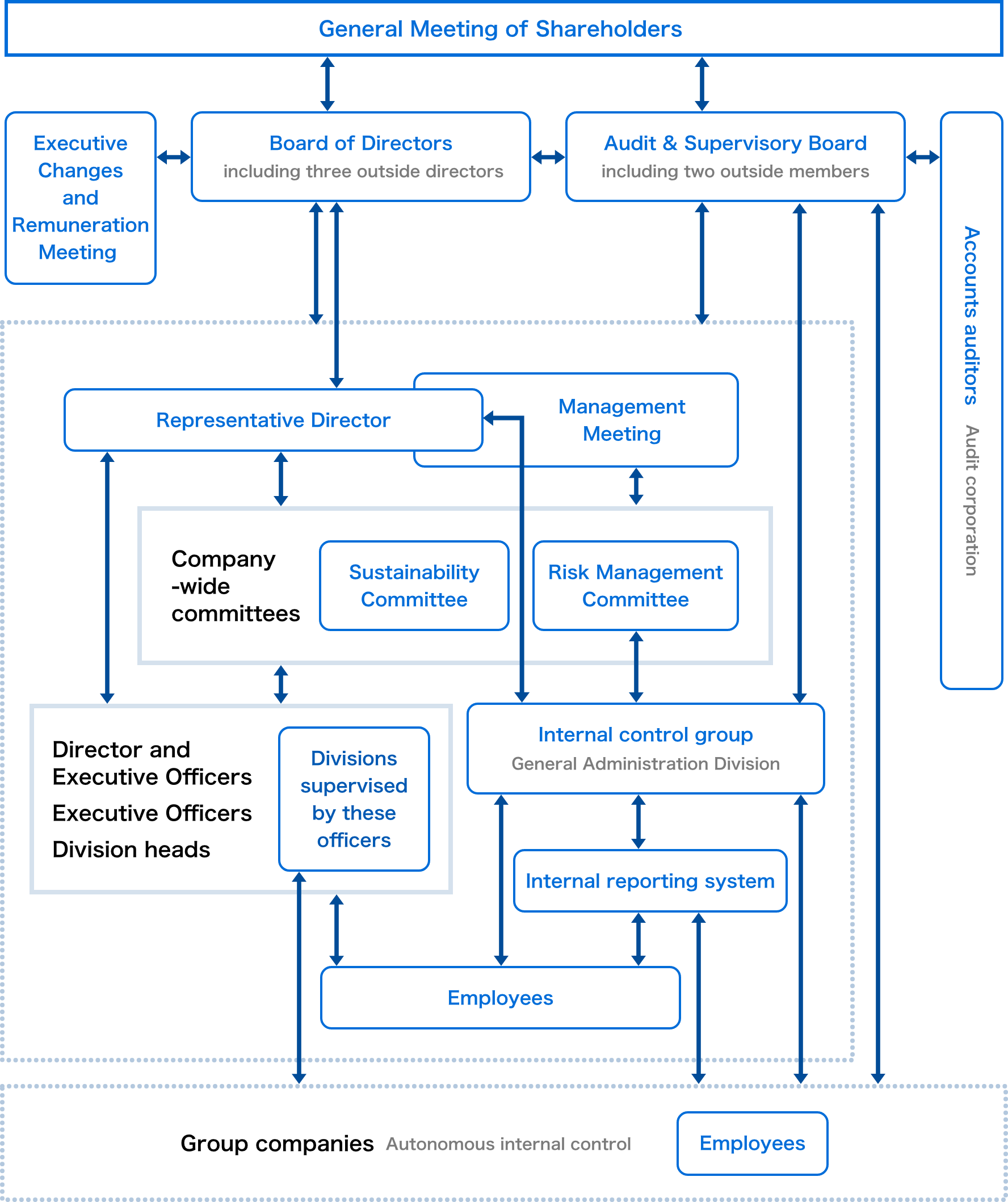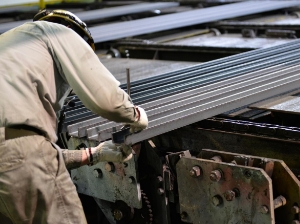Corporate governance
Basic approach
As the environment that surrounds its business undergoes greater changes, the Osaka Steel Group is striving to improve its corporate governance system to make swifter managerial decisions; ensure the efficiency, soundness, and transparency of management; enhance its corporate value continuously; and become a corporate group that is trusted by society.

Board of Directors and Directors
We stipulate in our articles of incorporation that Osaka Steel shall have twelve directors or less and a Board of Directors consisting of them, and in order to enhance the supervisory functions of the Board, we currently elect three independent outside directors thereto.
In principle, the Board of Directors holds one meeting per month and extraordinary ones as required. Directors make decisions swiftly and flexibly, and they support outside directors mainly by holding advance briefings for board meetings to provide them with full information and to ensure that smooth and active discussions are held. In accordance with the internal regulations, important matters involving the management of Osaka Steel and its group are discussed by the Management Meeting, which comprises the Representative Director & President and Directors & Executive Officers, and are then decided by the Board of Directors for execution.
In addition, we have company-wide committees established according to different purposes, including the Ordinary Budget Committee, Equipment Budget Committee, and Risk Management Committee, as deliberative organs that precede the Management Meeting and the Board of Directors, and these company-wide committees fulfill supplementary functions in management and execution.
Audit & Supervisory Board and Board Members
We have chosen to be a company with an audit & supervisory board and stipulate in our articles of incorporation that Osaka Steel shall have four Audit & Supervisory Board Members or less and an Audit & Supervisory Board consisting of them. In accordance with this stipulation, we currently elect four Audit & Supervisory Board Members (including two independent outside members) thereto.
Based on their rich business experiences, full-time Audit & Supervisory Board Members are engaged in daily audit operations in a systematic way while working with one another and they express their opinions actively at Board of Directors and other important meetings from independent standpoints, thus striving to maintain and improve the soundness of management. Outside Audit & Supervisory Board Members also do so from various experiences in their areas of expertise and from neutral and objective viewpoints.
Internal control and risk management systems
Under the Osaka Steel Group’s risk management system, the division in charge of risk management identifies and assesses the risks it supervises, establishes related regulations and other guidelines, and shares them with related divisions. In addition, the division in charge of risk management works with the internal control group in the General Administration Division to monitor the status of compliance, etc., and based on the status of the risk management that they analyze and assess, they give guidance and advice to improve risk management continuously.
The operation of the internal control system is confirmed and reported to the Board of Directors by the Risk Management Committee, where mainly senior managers as well as persons responsible for risk management at Osaka Steel and its group companies gather to discuss internal control policy, etc.
The implementation of internal control activities, results of internal audits, etc., in each fiscal year are reported to the Board of Directors by the relevant committee after evaluating the effectiveness of the internal control system at the end of the year. Based on the results of the evaluation, improvement measures to increase the effectiveness of the internal control system are formulated and reflected on operation plans related to internal controls for the next fiscal year.
Furthermore, in addition to the internal Compliance Consultation Office (an internal office to contact for consultation), we have also set up an external Compliance Consultation Office (an external office to contact for reporting) to prevent accidents and violations of laws and ordinances, ensure compliance, and make daily operations fair and reasonable.
Risk management
We will give top priority to safety, the environment, disaster risk reduction, and quality as we continue our business activities.
All-out efforts to eliminate disaster risks
The basic safety policy of the Group is “safety first.” The Safety & Environment Division strives to prevent work-related accidents and reduce disaster risks by stepping up efforts for patrol and monitoring and assessing safety and risks periodically. The Division also makes analyses to prevent similar disasters and applies examples of effective initiatives to the entire group, thus working on activities to achieve zero disasters on a group-wide basis.
Promotion of safety training
We strive to enrich training programs to prevent work-related accidents by providing less experienced employees at manufacturing sites with thorough safety guidance and training, including VR-based training and exercises to feel the danger in their body.
All-out efforts to eliminate disaster risks
The Group’s activities to reduce disaster risks consist of four priority items:
(1) stepping up fire and explosion risk management
(2) strengthening the disaster risk reduction system so that it functions when responding to disasters
(3) promoting measures to reduce risks involved in massive earthquakes
(4) conducting drills to respond to emergencies for disaster risk reduction
We take essential and fundamental measures to further reduce disaster risks at manufacturing sites continuously with the aim of reducing the number of serious accidents to zero.
Strengthening the quality control and quality assurance systems
The Quality Control Committee holds meetings periodically to report and discuss important matters related to quality control and quality assurance and to strengthen the group-wide quality control system. We implement the PDCA cycle effectively, thus striving to improve the quality management system on a continuous basis.
The basic policy of quality control and quality assurance is to identify customers’ quality requirements accurately through continuous demand surveys based on market strategy and to continuously enhance materials procurement technology, manufacturing technology, sales capabilities, and quality assurance capabilities to provide products that gain customers’ trust and satisfaction. In accordance with this policy, we work to strengthen the quality control and quality assurance systems by making efforts to raise the quality compliance awareness of all employees involved in manufacturing and services and prevent the occurrence of quality troubles.

Environmental risk management system
The Osaka Steel Group is striving to reduce environmental risks at the group-wide level through its environmental management system and is working to improve itself by implementing the PDCA cycle effectively at the Environmental Management Committee, which is convened periodically. At its meetings, the Committee reports the latest trends in environmental legislation and examples of environmental initiatives and share relevant information to reduce environmental risks. At the same time, we have established a system under which the Production & Technical Control Division and the Safety & Environment Division work together to report environmental risks, such as climate change and industrial waste, to the Management Meeting and the Board of Directors and receive supervision and advice from Directors.
Atmospheric risk management
We are implementing effective equipment measures, including using NOx regenerative burners to reduce NOx emissions, catching smuts and dust generated at raw material yards and other sites by installing dust collectors, and preventing the dispersion of smuts and dust by installing water sprinklers. Through the environmental management system, we establish independent management standards and monitor pollutants so that abnormal levels of pollutants are not discharged.
In April 2018, the amount of mercury discharged into the atmosphere started to be regulated, but our electric furnaces manage the concentration of mercury in line with the independent management standards set by the Japan Iron and Steel Federation (JISF) in April 2018, and the results of our initiatives and their evaluations are published on JISF’s website around September of each year.
Water risk management
We are striving to effectively utilize precious water resources and reduce the amount of wastewater by recycling approximately 80% of the industrial water used at all works. To that end, we are making continuous efforts every day to maintain and manage the functions of wastewater treatment equipment and inspect the quality of wastewater carefully.
Environmental audits
In accordance with the ISO 14001 international standards, we have established an environmental management system with the manager of each division as its head. We conduct management review through internal audits each year and have the system reviewed by ISO-certified organs periodically.